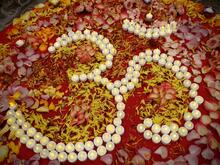
The lights of Diwali
This is an exerpt from Dr. Shipman’s Chapel Talk, delivered to The Groton School community on October 29, 2019 as a part of their Diwali celebration.
“Let’s now turn to Diwali. This Hindu Festival of Lights has a few names and is associated with many sacred stories, spiritual practices, philosophies and family traditions. The celebration spans five or six days, varying by region, and today is the last day of Diwali for this year. Diwali derives its name from the clay oil lamp called a diya. Diyas are hand crafted little cups with flattened rims painted in bright colors and filled with oil. A cotton wick is placed half in the oil and half on a little shelf on the rim of the diya. Here’s the challenge with oil lamps. They won’t burn properly if the wick is placed too far in or too far out of the oil. Over thousands of years Hindus have poked at the wicks during ceremonies, replenished them or relit them because they were too high or low in the oil. In our modern tea light era this isn’t much of an issue. Still there’s an important lesson to consider. Sri Sri Ravishankar, a Hindu monk and visionary suggests that
“Life is like the wick of the lamp, you have to be in the world and yet remain untouched by it. If you are drowned in the materialism of the world, you cannot bring joy and knowledge in your life. By being in the world, yet not drowning in the worldly aspect of it, we can be the light of joy and knowledge. [Diwali message 2010, https://www.artofliving.org/in-en/diwali-celebrating-light-wisdom]”
The diyas do not exist as single entities during this festival. Across India families place rows of oil lamps along the foundations, entry paths and balconies of their dwellings. And that gives forth another name for the celebration: Deepavali. Deep, another name for the oil lamp, and avali which means “rows or clusters of lamps.” This is the name that South Indians most often use; North Indians tend to use Diwali. As the days grow short during this time of year the rows of diyas give off a powerful glow, intended to dispel the darkness, just as knowledge dispels fear and ignorance. They are also placed to entice Lakshmi, the goddess of wealth and well-being into the residence.
On the main Diwali day, Hindus will dress in new clothes and host worship services to Lakshmi and Ganesha in their homes or go to the Temple. Prayers to Ganesha entreat Him to ensure that any obstacles are removed so that Lakshmi’s path to the home is unimpeded. The prayers also ignite the internal light of the atman and all those atmans in congregation beam a brilliant light into the universe.”
May we shine our inner light brightly into this beloved world, so much in need of hope, joy and healing!